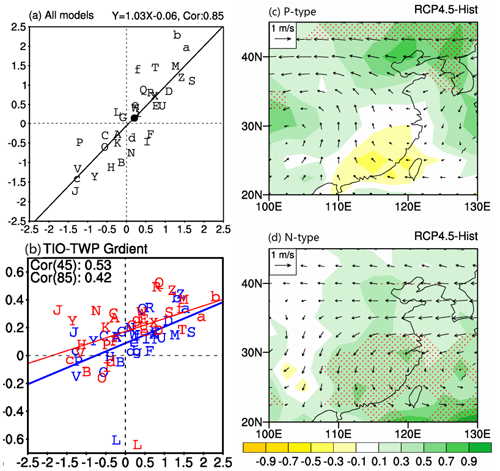How will the western North Pacific subtropical High change in response to global warming?
Date:2014-11-20
The western North Pacific subtropical High (WNPSH) has great influence on the climate of eastern China in summer. The mechanisms for the interannual and intraseasonal variability of WNPSH has been well studied, but it is still unknown how the intensity of the WNPSH will change in response to global warming.
The research team of Dr ZHOU Tianjun Zhou has investigated the projected changes of the WNPSH using the RCP4.5 and RCP8.5 warming scenarios of 33 CMIP5 models. The results show that the projected changes in the WNPSH intensity is highly inconsistent among the models (Fig. 1a). About half of the models project enhanced WNPSH and about half of the models project weakened WNPSH, under both RCP4.5 and RCP8.5 scenarios. The multi-model ensemble mean (MME) projects little change in the WNPSH intensity. Further investigation on the inter-model spread shows that the projected changes in the WNPSH intensity depends on the change of the zonal SST gradient in the tropical oceans. Stronger (weaker) warming of the tropical Indian Ocean than the tropical western Pacific Ocean is in favor of an enhanced (weakened) WNPSH in the projection (Fig. 1b). The rainfall pattern in eastern China is regulated by the changes in the WNPSH intensity. Models with an enhanced (weakened) WNPSH are associated with increased precipitation over the northern (southern) part of eastern China, accompanied by enhanced (weakened) southerly wind.
The above finding is published early on-line by Journal of Climate.

Fig.1 (a) Projected changes in the WNPSH intensity projected by 33 CMIP5 models. The abscissa and the ordinate are for the RCP4.5 and RCP8.5 scenarios, respectively. The alphabetical letters represent the individual models and the solid black circle represents the MME. (b) The relationship between the changes in the WNPSH intensity (abscissa) and the changes in the TIO-TWP SST gradient (ordinate) for the 33 models. The blue and red letters are for the RCP4.5 and RCP8.5 scenarios, respectively. (c) The composite change in the rainfall and 850hPa wind over eastern China by the models which project significantly enhanced WNPSH at the 95% confidence level. (d) The composite change in the rainfall and 850hPa wind over eastern China by the models which project significantly weakened WNPSH at the 95% confidence level.
Reference:
He, C., and T. Zhou, 2014: Responses of the western North Pacific Subtropical High to global warming under RCP4.5 and RCP8.5 scenarios projected by 33 CMIP5 models: The dominance of tropical Indian Ocean - tropical western Pacific SST gradient. J. Climate. doi:10.1175/JCLI-D-13-00494.1, in press.
